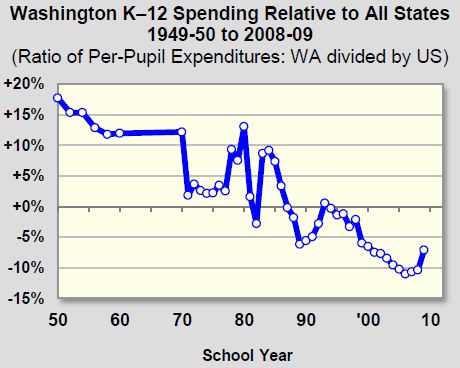When Washington’s Supreme Court found the state legislature “has not complied with it’s constitutional duty to make ample provision for the education of all children in Washington” (see McCleary vs. State of Washington), legislators gave the Washington State Institute of Public Policy* this question to answer: “If K–12 spending is increased, is there reason to believe that student outcomes will improve and, if so, by how much?”
WSIPP’s two-part answer: Yes – especially with younger students:
First, the weight of the evidence indicates that, on average, there is a positive relationship between K–12 per-pupil expenditures and student outcomes. Second, the effect appears to be stronger in lower school grades than in upper grades.
 To arrive at this conclusion, WSIPP researchers looked at historical K-12 funding data from Washington and around the country. Overall, they found that while Washington’s inflation-adjusted per-pupil spending had increased since 1950, its rate of increase had been much lower than most other states (see graph at right).
To arrive at this conclusion, WSIPP researchers looked at historical K-12 funding data from Washington and around the country. Overall, they found that while Washington’s inflation-adjusted per-pupil spending had increased since 1950, its rate of increase had been much lower than most other states (see graph at right).
Once it was determined that Washington was funding K-12 education at a lower rate than most other states, WISPP then sought to establish whether or not “money matters” in K-12 educational outcomes. Analyzing data from around the country, WISPP found “40 credible evaluations of the degree to which K–12 per-pupil expenditures have a cause-and-effect relationship with student outcomes.”
Translation: yes, funding matters. These evaluations found that especially among lower grades,more funding led to better outcomes in standardized test scores, high school graduation rates, and dropout rates.
WSIPP estimates the practical magnitude of a 10% increase in spending would be a long-term improvement of 3.7% in graduation rates.
This isn’t breaking news, especially for teachers and administrators who see the effects of state budget cuts in their classrooms and school buildings first-hand. But it is an important reminder that adequate funding for K-12 education – which often receives second billing to buzzwords like “flexibility” and “innovative approaches” – is critical to better educational outcomes.
*Created by Washington’s Legislature in 1983, the Washington State Institute for Public Policy (WSIPP) carries out “practical, non-partisan research—at legislative direction—on issues of importance to Washington State.” It has policy analysts and economists on staff, and provides high-quality research to answer legislative questions.
More To Read
March 24, 2025
Remembering former Washington State House Speaker Frank Chopp
Rep. Chopp was Washington state’s longest-serving Speaker of the House
February 11, 2025
The rising cost of health care is unsustainable and out of control
We have solutions that put people over profits
January 29, 2025
Who is left out of the Paid Family and Medical Leave Act?
Strengthening job protections gives all workers time they need to care for themselves and their families
